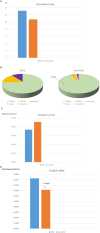New insights in the role of Candida biofilm in the pathogenesis of recurrent vulvovaginal candidiasis: a prospective clinical study
- PMID: 40212387
- PMCID: PMC11983648
- DOI: 10.3389/fmicb.2025.1566171
New insights in the role of Candida biofilm in the pathogenesis of recurrent vulvovaginal candidiasis: a prospective clinical study
Abstract
Background: Despite the pathogenesis of vulvovaginal candidiasis (VVC) is multifactorial, this study aimed to assess whether phenotypic characteristics, such as biofilm production and quality, along with clinical symptoms, are associated with recurrent VVC (RVVC).
Methods: Over 1 year (Oct 2021-Oct 2022), we prospectively included 271 patients ≥18 years who attended our institution, had Candida spp. isolated in vaginal swabs, and provided informed consent. Patients were followed for 1 year. Candida spp. isolates were tested by the following techniques: crystal violet (CV) for biomass quantification, XTT for metabolic activity quantification, and microscopy for biofilm area quantification. Clinical and microbiological data were also collected.
Results: Overall, 55 (20.3%) patients experienced at least one recurrence, with 19 (7.0%) meeting the criteria for RVVC (≥3 episodes/year), with 65 episodes in total. Demographic and clinical characteristics were similar in both study groups. Most isolates were C. albicans (90.0%). Median (interquartile, [IQR]) absorbance values for CV and XTT in 18/19 RVVC and 238/252 non-RVVC isolates were as follows: CV, 1.850 (1.578-2.156) vs. 1.426 (1.081-1.823), p = 0.005; XTT, 0.184 (0.116-0.293) vs. 0.228 (0.147-0.331), p = 0.253. Median (IQR) biofilm occupation area percentage in 16/19 RVVC and 16/252 non-RVVC isolates was, respectively: 13.15 (8.54-16.9) and 10.73 (5.88-17.73), p = 0.710.
Conclusion: RVVC was associated to high biomass production. Additionally, RVVC clinical isolates exhibited a tendency toward lower metabolic activity, which may contribute to treatment failure.
Keywords: biofilm; biomass; metabolic activity; pathogenesis; recurrent vulvovaginal candidiasis.
Copyright © 2025 Díaz-Navarro, Irigoyen-von-Sierakowski, Delcán, Monte, Palomo, Escribano, Guinea, Burillo, Galar, Muñoz and Guembe.
Conflict of interest statement
JG reports a relationship with Pfizer Inc., Gilead Sciences Inc., Merck Sharp & Dohme UK Ltd. that includes: speaking and lecture fees. The remaining authors declare that the research was conducted in the absence of any commercial or financial relationships that could be construed as a potential conflict of interest. The author(s) declared that they were an editorial board member of Frontiers, at the time of submission. This had no impact on the peer review process and the final decision.
Figures


References
LinkOut - more resources
Full Text Sources
Miscellaneous

